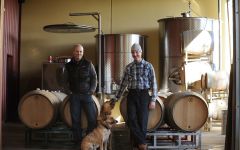Arnot-Roberts Touriga Nacional Rose 2019



Product Details
Your Rating
Somm Note
Winemaker Notes
The 2019 Arnot-Roberts Touriga Nacional Rose has a vibrant personality with fine tannins and bright acidity. The fruit from both of these vineyard sites is crushed lightly prior to pressing to release some color, then fermented with native yeasts and aged in stainless steel.
Blend: 80% Touriga Nacional, 20% Tinta Cao









Arnot-Roberts was Founded in 2001 in Healdsburg, CA by childhood friends, Duncan Arnot Meyers and Nathan Lee Roberts. The focus of this two person operation is on small lot, single vineyard Cabernet Sauvignon, Syrah, Chardonnay, as well as several other varieties uncommon in Northern Californian vineyards. Sites are carefully chosen and are generally on the cooler end of the spectrum for the planted varieties. Collaboration with dedicated and passionate growers is paramount in the farming of these sites.
Duncan and Nathan grew up around winemaking in the Napa Valley. Nathan is a second generation cooper and personally builds all of the French oak barrels that are utilized in the ageing of all Arnot-Roberts wines. Over the years Duncan has worked making wine in the Napa Valley in wineries like, Caymus, Groth, Acacia, Kongsgaard.
Total production of Arnot-Roberts is around 2,000 cases per year with thirteen individual wines. Both primary and secondary fermentations are carried out utilizing native yeast. For the Syrahs whole clusters are retained during primary fermentation before being basket pressed to French oak barrels. For the Cabernets, hillside sites of intense character are chosen, small amounts of whole clusters are retained during primary fermentation and the wines are aged for two years in varying amounts of new French oak cooperage, selected and toasted to meld with the vintage at hand. White wines are whole cluster pressed and stainless steel fermented with native yeast, then aged in neutral French oak barrels.

Whether it’s playful and fun or savory and serious, most rosé today is not your grandmother’s White Zinfandel, though that category remains strong. Pink wine has recently become quite trendy, and this time around it’s commonly quite dry. Since the pigment in red wines comes from keeping fermenting juice in contact with the grape skins for an extended period, it follows that a pink wine can be made using just a brief period of skin contact—usually just a couple of days. The resulting color depends on grape variety and winemaking style, ranging from pale salmon to deep magenta.

Responsible for the vast majority of American wine production, if California were a country, it would be the world’s fourth largest wine-producing nation. The state’s diverse terrain and microclimates allow for an incredible range of red wine styles, and unlike tradition-bound Europe, experimentation is more than welcome here. California wineries range from tiny, family-owned boutiques to massive corporations, and price and production are equally varied. Plenty of inexpensive bulk wine is made in the Central Valley area, while Napa Valley is responsible for some of the world’s most prestigious and expensive “cult” wines.
Each American Viticultural Area (AVA) and sub-AVA of has its own distinct personality, allowing California to produce red wine of every fashion: from bone dry to unctuously sweet, still to sparkling, light and fresh to rich and full-bodied. In the Napa Valley, Cabernet Sauvignon, Merlot, Chardonnay and Sauvignon Blanc dominate vineyard acreage. Sonoma County is best known for Chardonnay, Pinot Noir, Cabernet Sauvignon, Rosé and Zinfandel. The Central Coast has carved out a niche with Rhône Blends based on Grenache and Syrah, while Mendocino has found success with cool climate varieties such as Pinot noir, Riesling and Gewürztraminer. With all the diversity that California wine has to offer, any wine lover will find something to get excited about here.
